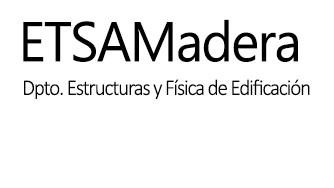Author: Lara-Bocanegra, A.J.
Supervisor: Guaita Fernández, M. & Arriaga Martitegui, F.
University: Higher Tech. School of Architecture of Madrid (ETSAM) | Tech. University of Madrid (UPM)
Abstract
Elastic timber gridshells are a highly efficient and architecturally expressive structural solution of great interest for application in lightweight roofs of medium and large spans. They are built from initially straight pieces of wood, of small cross-section and great length, which are elastically deformed until they reach the target shape, resulting in a structural grid of continuous elements.
The use of identical timber laths and simple connection solutions gives the system a high capacity for prefabrication and standardisation. However, despite the great potential of this type of structures, only a few singular realisations have been built to date. This is due to important difficulties during the design and construction process that prevent their popularisation, such as the scarcity of suitable commercial timber products, the insufficiency of studies on stress relaxation in bent timber laths, and the lack of work on experimentally verified numerical models. The general objective of the present PhD thesis is to provide useful knowledge to overcome these difficulties and to achieve the implementation of this type of structures using Eucalyptus globulus Labill wood.
To this end, the main guidelines for producing high performance finger jointed solid timber and glued laminated timber of E. globulus for application in elastic gridshells are established. A grading system of eucalyptus solid wood into different strength profiles is proposed, combining visual and mechanical criteria. Manufacturing parameters necessary to get very high capacity finger-joints are also set up. The results show that E. globulus can be used to produce two of the highest mechanical performance solid wood-based products on the European market, representing a high added-value alternative application for this species, which is normally used for pulp production. A comparative analysis with other products and wood species, in terms of radius of curvature, stiffness of the connection system, and structural reserve, shows the mechanical superiority of the developed products and demonstrates that they can be used to design gridshell structures that would not be possible with other species.
A critical literature review is also carried out on the phenomenon of stress relaxation in elastically bent timber laths, in relation to the structural analysis approaches, the equipment and test methods applied, and the available experimental data. This research has derived in a patent with examination of a novel test equipment, which eliminates the drawbacks of other devices used for the same purpose. The new equipment has been applied to measure the stress relaxation produced over several years in curved eucalyptus laths with different radii. The results provide data of great interest for structural analysis and suggest the possibility of using normative creep values to estimate stress relaxation in other species.
An innovative concept of an elastic timber gridshell is also proposed, which makes an important contribution to the design of this type of structure and opens up new and interesting application possibilities. It is based on a structural scheme of a long gridshell supported exclusively on its short sides, which achieves out-of-plane bending stiffness by means of three directions of bent laths.
To analyse the structural behaviour of the proposed concept, two novel numerical finite element models are developed which incorporate the most important aspects of this type of structure (eccentricity and slip at the joints, and bending stresses and their relaxation). Both are based on modelling the joints of the structure as a sequence of rigid couplings with springs in all shear planes. The first simulates the final geometry to be built, being able to incorporate the initial stresses due to the construction process by means of bending moments deduced from the geometrical analysis. The second reproduces the construction process by obtaining the initial stresses directly from the simulation. From the numerical results obtained, the main aspects to be considered in the design and structural analysis of the developed concept are pointed out.
Finally, two large gridshells are built with the proposed new structural scheme. The first, a 7.5 m long laboratory prototype, allows the numerical models to be calibrated on the basis of a load test. The second, a 24 m long structure designed to cover the new wood warehouse of PEMADE on the Lugo Campus, is the first permanent elastic timber gridshell built in Spain and the first in the world to be made with E. globulus. Within this project, additional work was caried out to achieve continuous long laths without mechanical joints. Innovative structural details were also developed, and a lath-by-lath construction process was proposed, which allows three directions of continuous bent laths and avoids the use of shear blocks. The design and construction of this structure definitively demonstrate the architectural and structural potential of Eucalyptus globulus Labill for application in elastic gridshells and opens up new exciting avenues yet to be explored.
The work developed in this thesis has been carried out in the framework of three research projects: “Technification of the value chain for the development of products with high technical solicitations with eucalyptus wood” (Xilográcile), from the FEDER Innterconecta Programme of the Ministry of Science and Innovation of the Spanish Government; “Analysis of the stress relaxation in curved members and new joints solutions for timber gridshells made out of Eucalyptus globulus” (Eucagrid), from the State Programme for the promotion of scientific and technical research of excellence, of the Ministry of Economy and Competitiveness of the Spanish Government; and “Lugo+Biodinamic, Planning of a multi-ecological neighbourhood model of urban resilience”, from the LIFE Programme of the European Union.
This doctoral thesis is presented as a compendium of publications. Its content is articulated through six of the most relevant contributions made by the author in the field: five articles in Q1 or Q2 scientific journals (one of them under review) and one patent with prior examination.
Access to the full text (UPM users only) at: 10.20868/UPM.thesis.70673
